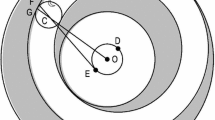Abstract
Johann Heinrich Lambert, a Swiss-German scholar, was counted among the most famous men of his time. Being an autodidact and without formal university studies, he won access to the modern sciences, in particular to philosophy, mathematics, astronomy and physics; and indeed he was most successful in all these fields. In the area of mathematics, for example, he made contributions to the theory of irrational numbers (continued fractions), to the problem of parallel lines and non-Euclidian geometry, to trigonometry (group-theoretical formulation of Nepper's rule), the foundations of the perspective, he gave a proof for the irrationality of e and π and moreover some remarkable indications for their transcendency, to mention only a few. In the field of astronomy, he made contributions not only to the foundations of photometry but also to the orbital determination of planets and comets, which culminated in ‘Lambert's Theorem’. This, as well as his ‘Cosmologische Briefe’ (with which he made a contribution to the structure of the world parallel to the Kantian view) is the subject matter of the following report. Even in philosophy Lambert kept pace with Kant (‘Criterium veritatis’, 1761 when he said: “Wir wissen, dass Gestalt und Grösse vom Orte umabhängige Bestimmungen sind”.).
Zusammenfassung
Johann Heinrich Lambert, ein deutsch-schweizer Wissenschaftler, gehörte zu den berühmtesten Männern seiner Zeit. Er hat als Autodidakt ohne Studium an einer Hochschule sich den Zugang zu den modernen Wissenschaften, insbesondere zue Philosophie, zur Mathematik, zu Astronomie und Physik geschaffen und auf diesen Gebieten Fortschrittliches geleistet. Auf dem Gebiete der Mathematik z.B. waren es seine Beiträge zur Theorie der Irrationalzahlen (Kettenbrüche), zum Problem der Parallellinien und der nichteuklidischen Geometrie, zur Trigonometrie (gruppentheoretischer Ansatz für die Neppersche Regel), die Begründung der Perspektive, Beweis der Irrationalität von e und π mit Ansätzen zum Nachweis ihrer Transzendenz, um nur einiges herauszuheben. Auf dem Gebiete der Astronomie waren es neben seinen Grundlagen für die Photometrie seine Beiträge zur Bahnbestimmung von Planeten und Kometen, die er mit dem nach ihm benannten Lambertschen Theorem krönte. Darüber und über seine ‘Cosmologischen Briefe’, mit denen er einen Beitrag zur Struktur der welt parallel zu der von Kant gegeben hat, wird im folgenden ausführlich gehandelt. Auch in der Philosophie war er im Gleichschritt mit Kant (‘Criterium veritatis’ 1761 mit dem Ausspruch: “Wir wissen, daß Gestalt und Größe vom Orte unabhängige Bestimmungen sind.”).
Similar content being viewed by others
Author information
Authors and Affiliations
Additional information
Proceedings of the Sixth Conference on Mathematical Methods in Celestial Mechanics held at Oberwolfach (West Germany) from 14 to 19 August, 1978.
Rights and permissions
About this article
Cite this article
Volk, O. Johann Heinrich Lambert and the determination of orbits for planets and comets. Celestial Mechanics 21, 237–250 (1980). https://doi.org/10.1007/BF01230902
Issue Date:
DOI: https://doi.org/10.1007/BF01230902




